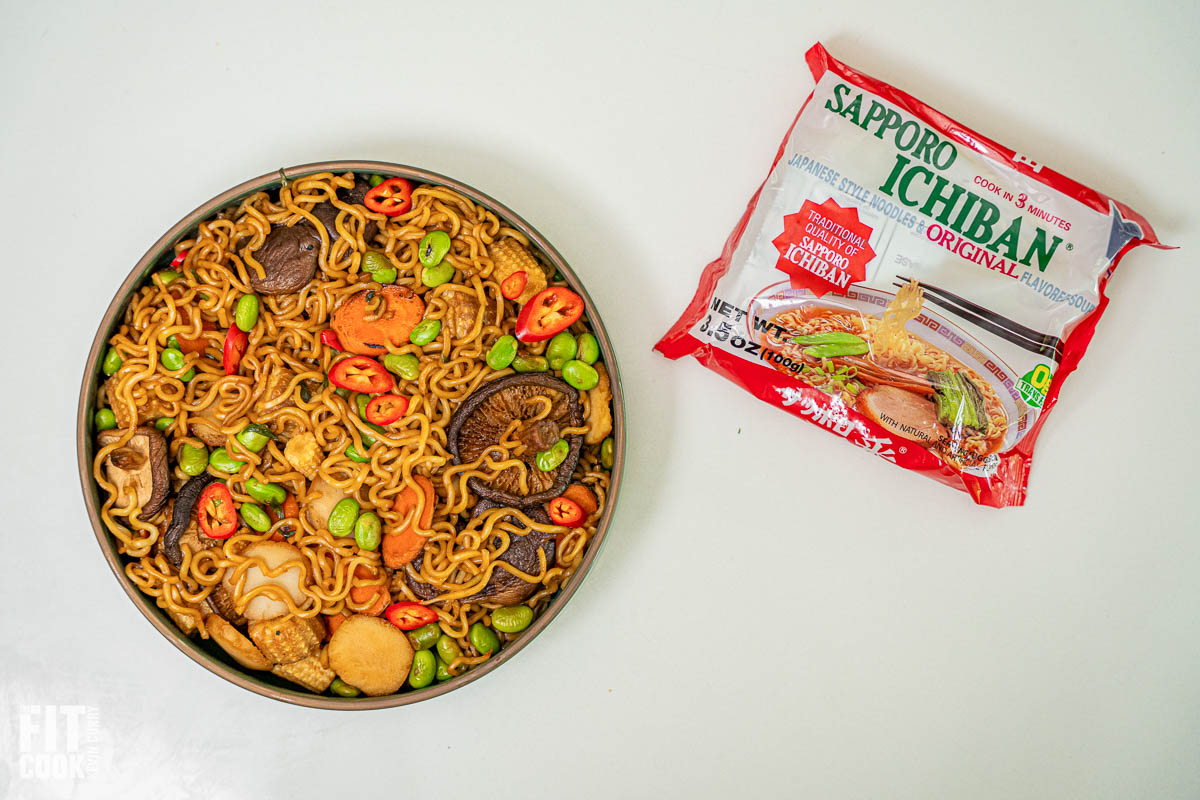[ad_1]
Welcome to the delicious world of healthy ramen – yep, you heard that right, I’m talking about transforming everyone’s favorite college comfort food into a nutritious powerhouse that’ll turn your ramen cravings into a guilt-free indulgence.
I’m Kevin Curry, your guide to all things tasty and wholesome, and today, I’m diving fork-first into the wonderful realm of ramen reimagined.
So, what’s the problem with the OG bowl of ramen? Well, let’s face it – as much as we adore the instant ramen seasoning packets of yore, they’re not exactly the poster child for nutritious eats. Loaded with sodium, unhealthy fats, and enough preservatives to make your head spin, they’re more like a fast track to feeling sluggish than a nourishing meal. But no worries, my fellow ramen lovers, because there’s a better way – one that’ll give you all the lip-smacking goodness of ramen while also giving your body the care and nutrients it deserves.
Imagine steam rising from a bowl packed with slurp-worthy noodles, an aromatic broth swirling with goodness, and a medley of vibrant veggies adding color and crunch. Ah, the nostalgia of those late-night college cram sessions but healthier! 🤤
Here’s why you’ll love this upgrade: you’ll enjoy improved energy levels to power through those study sessions or work deadlines, glowing skin thanks to all the vitamins and minerals packed into those veggie-filled bowls, and a happy gut that’ll thank you for skipping the sodium overload. Plus, let’s not forget the satisfaction of knowing that we’re treating ourselves to something that not only tastes amazing but also supports our overall well-being.
So, get ready to slurp away to a happier, healthier you!
How to Make Ramen Noodles Recipes Better and Healthier
Before we jump into specific recipes, let’s elevate your ramen game while keeping it healthy and delicious.
Here are my top tips for throwing together the perfect, custom bowl of healthy ramen:
Craft Your Own Broth
Ditch the packets and take control of your broth. Homemade broth lets you skip preservatives and excess sodium, adding in lean proteins and veggies for a nutrient-packed base. If you’re pouring in a pre-made broth, opt for low-sodium options to avoid recreating the excess sodium issue. Up the flavor with onion, garlic, or ginger for depth and added health benefits. And if you’re a fan of easy ramen noodle soup, just pour on an extra helping of that delicious broth.
Make it Saucy
Sauces can enhance flavor, but choose wisely. Opt for low-sugar, low-sodium options like naturally brewed soy sauce or tamari. Use shrimp paste and miso paste sparingly for depth without overwhelming saltiness. For a creamy base, swap out cream of mushroom soup for plant-based milk or coconut milk to avoid excess saturated fat and sodium.
Veggie Up
Load up on veggies for a nutritious boost. Packed with vitamins, minerals, and fiber, they keep you feeling great. Mix in colorful options like leafy greens and bell peppers for variety in nutrients and flavor.
Add Protein
Lean proteins like chicken, fish, soft-boiled egg, or tofu provide essential amino acids for muscle repair and growth. Balance your bowl with lean cuts or plant-based options.
Add Some Toppings
Toasted sesame seeds or nuts add texture and flavor without sacrificing healthiness, offering healthy fats and protein. Spice things up with chili peppers or hot sauce to boost metabolism and add a kick. Get creative with nutritious options like fresh herbs and seaweed for unique flavors. And garnish with fresh herbs, green onions, or sliced veggies for added color, freshness, and nutrients.With these tips, you can enjoy a bowl of ramen that’s both nutritious and delicious. And if you’re feeling extra adventurous, try out an easy homemade ramen noodle recipe as well.
Let’s get creative and whip up some healthy, flavorful ramen together!
How to Prepare Ramen Noodle Recipe
Cooking ramen noodles is a breeze, my friends! Follow these simple steps for noodle perfection:
- Boil Water: Start by bringing a pot of water to a lively boil. You want enough water to fully immerse your noodles, around 2-3 cups per serving.
- Add Noodles: Once your water is bubbling away, gently drop in your ramen noodles. Use your trusty tongs or chopsticks to give them a little nudge, making sure they don’t stick together.
- Cook to Desired Texture: Let those noodles dance in the boiling water for about 2-3 minutes. Give them the occasional stir to ensure they’re cooking evenly. Keep a close eye on them – ramen noodles go from al dente to mushy in the blink of an eye!
- Test for Doneness: After a few minutes, pluck out a noodle and give it a taste test. You’re aiming for that perfect balance of firm yet tender. If they’re still a bit too toothy for your liking, let them simmer for another minute or so.
- Drain and Rinse (Optional): Once your noodles are just right, take them off the heat and drain them in a colander. Some folks like to give their noodles a quick rinse under cold water to stop them from cooking further and prevent them from sticking together. It’s up to you!
- Serve Immediately: Transfer your freshly cooked noodles to a bowl and get ready to add your favorite broth, toppings, and seasonings. Serve up your steaming bowl of ramen right away and savor every delicious slurp!
And there you have it, folks! With these easy steps, you’ll be whipping up restaurant-worthy ramen noodles in no time. So grab your chopsticks and get ready to enjoy a bowl of noodle nirvana.
Are Ramen Noodles Bad for You?
Ah, the age-old question: Are ramen noodles bad for you? Let’s dive into it…
Ramen noodles often get a bad rap, and rightfully so if we’re talking about the instant, packaged varieties loaded with sodium and preservatives. These convenient options may be quick and easy, but they’re not exactly winning any health awards.
The main concern with instant ramen noodles is their high sodium content. Excessive sodium intake has been linked to a range of health issues, including high blood pressure, heart disease, and stroke. Plus, many instant ramen noodles are made with refined flour, which lacks the fiber and nutrients found in whole grains.
But fear not, noodle lovers, because not all ramen noodles are created equal! When prepared mindfully and with wholesome ingredients, ramen can actually be a nutritious and satisfying meal.
Opting for whole grain or gluten-free noodles can boost the fiber and nutrient content of your ramen, making it a more balanced option. Additionally, loading up your bowl with plenty of veggies, lean proteins, and homemade broths can further enhance its nutritional value.
Homemade ramen allows you to control the ingredients, ensuring you’re not loading up on unnecessary additives or excess sodium. Plus, getting creative with your toppings and seasonings can add flavor without sacrificing healthiness.
So, are ramen noodles inherently bad for you? It all comes down to how they’re prepared and what ingredients you choose to include. With a little creativity and mindfulness, ramen can absolutely be a wholesome and delicious addition to your meal rotation.
Top 8 Easy Ramen Noodle Recipes
I’m thrilled to share with you some of my absolute favorite ramen recipes! Get ready to elevate your noodle game with these mouthwatering creations that’ll have you slurping up every last drop.
[ad_2]
Source link




